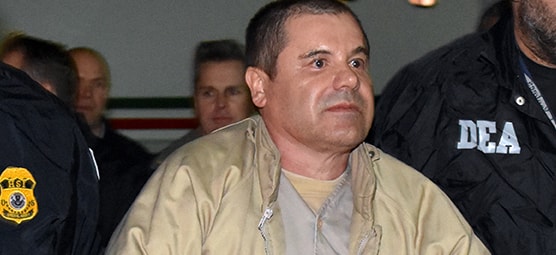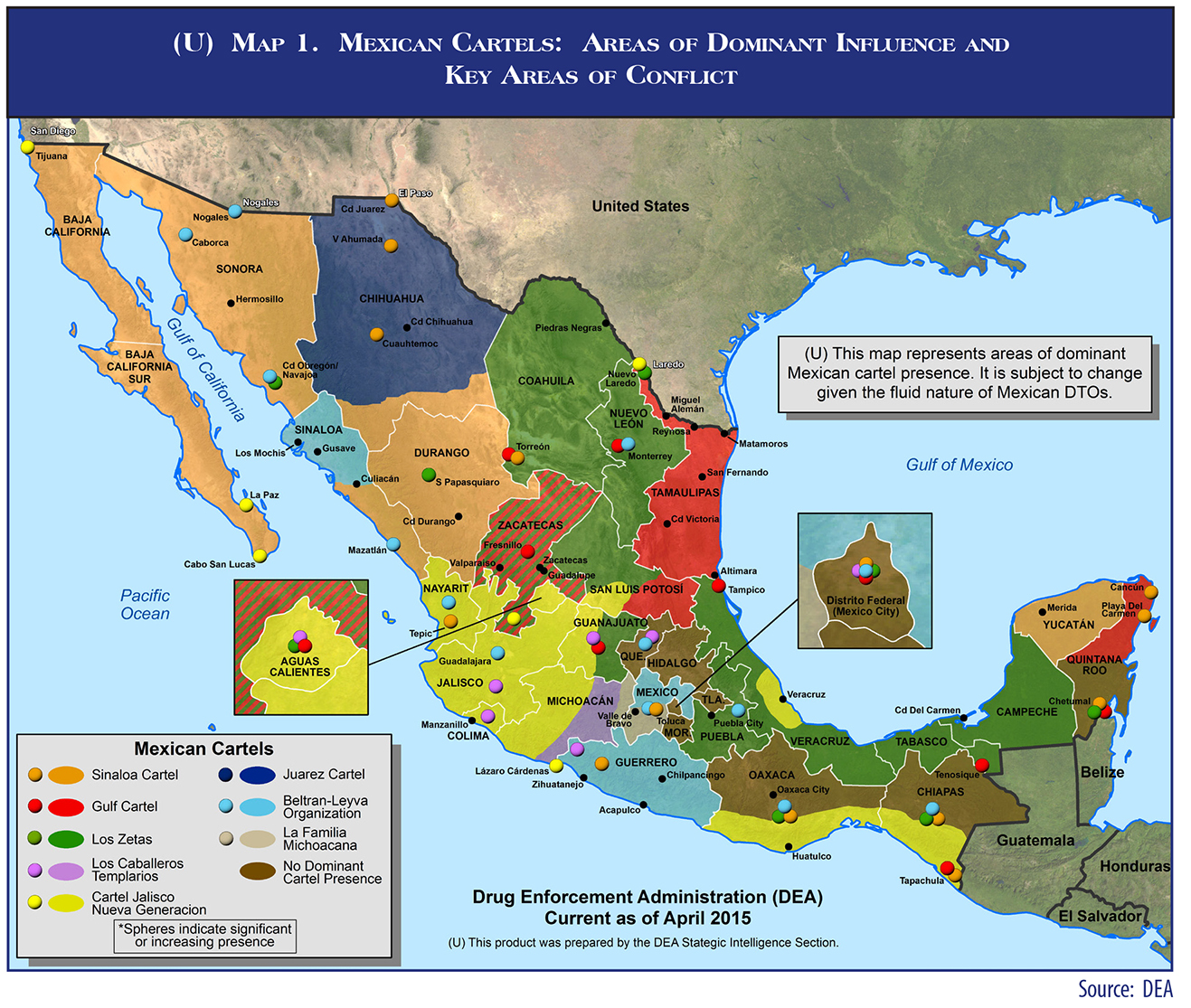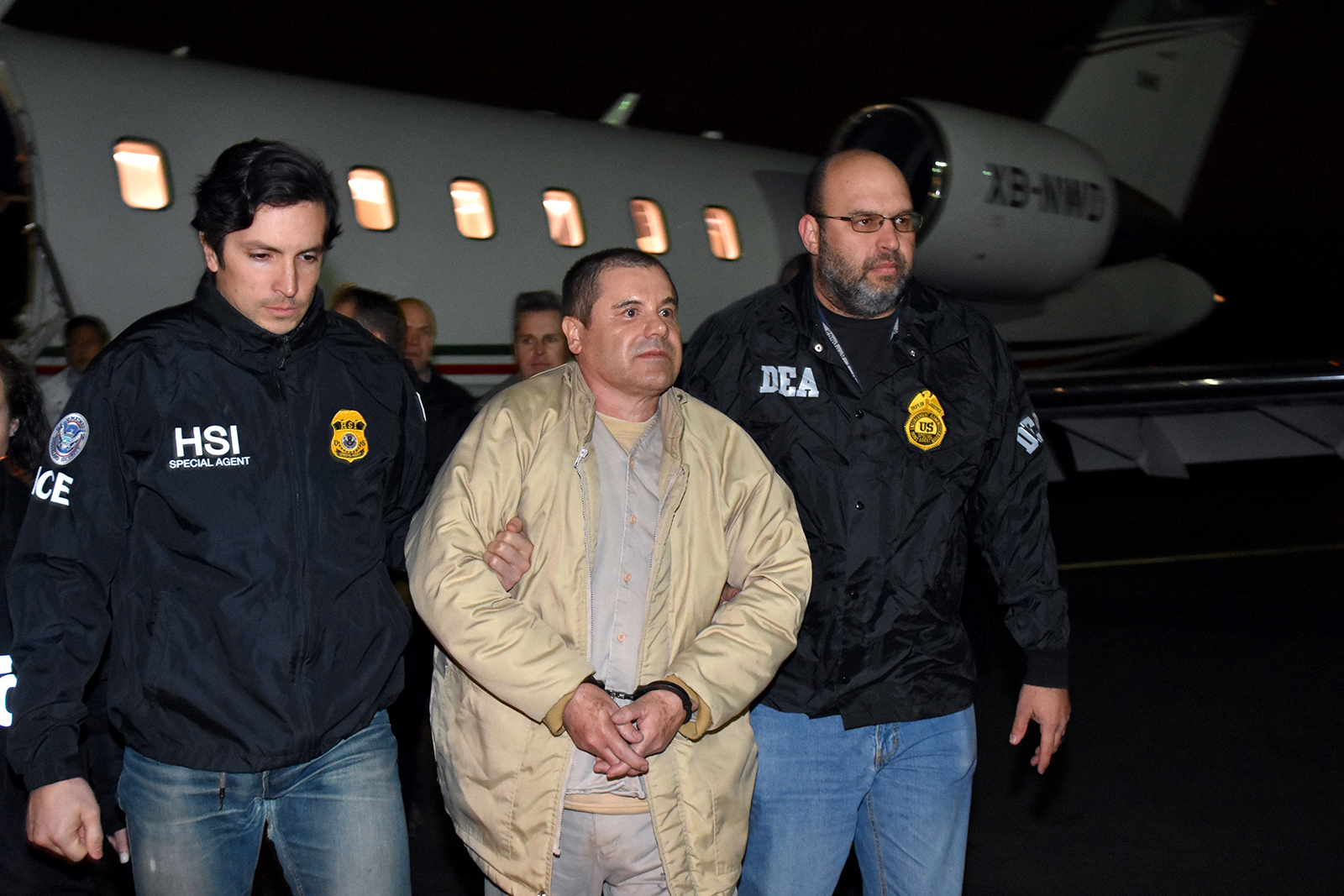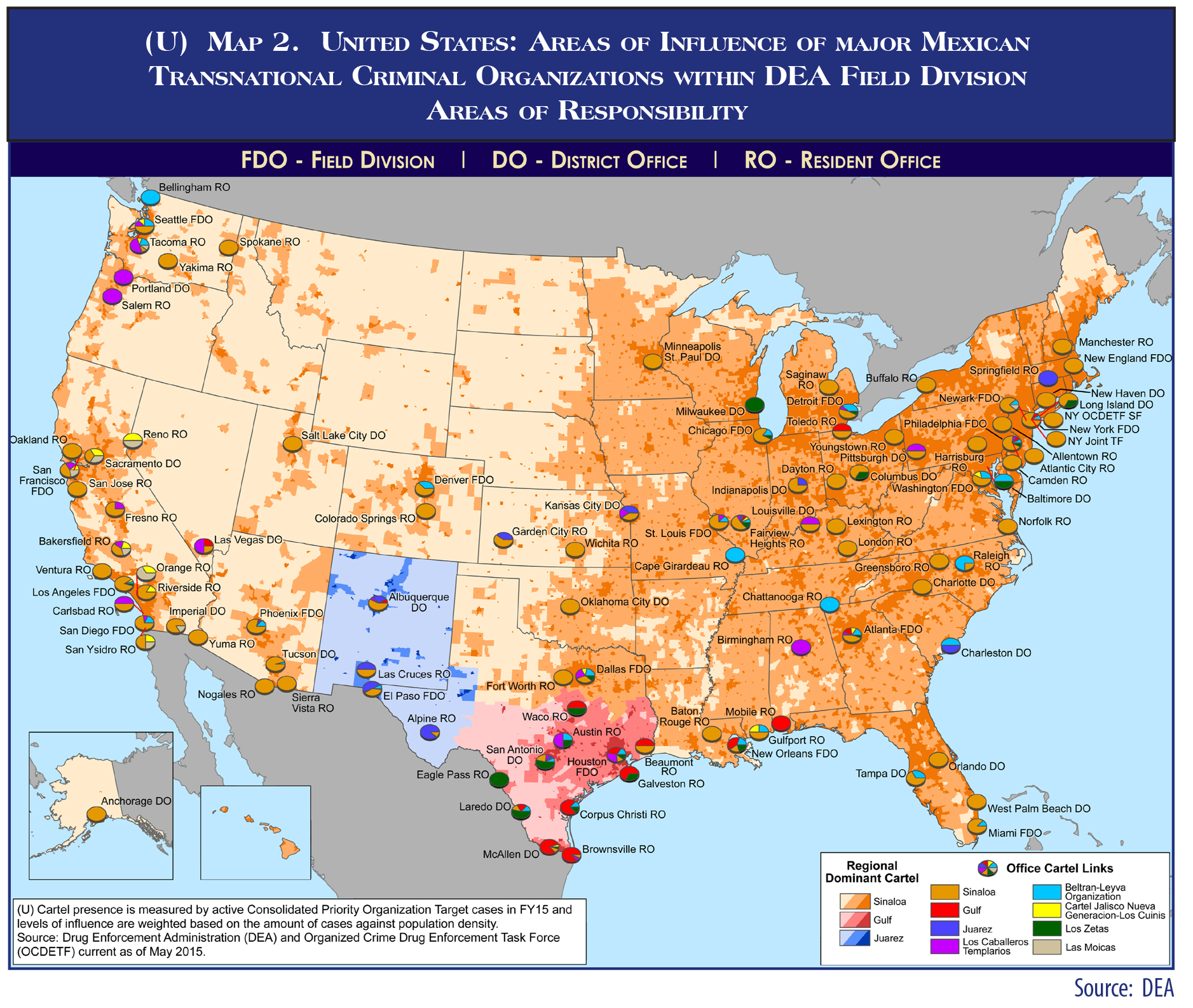El Chapo’s lawyers complain about strict rules at New York prison
Prosecutors contend Mexican drug lord poses dangers even in American custody

The lawyers defending accused Sinaloa Cartel drug kingpin Joaquin “El Chapo” Guzman are claiming that on its last day in office in January, the Obama administration arranged to extradite Guzman from Mexico to New York without legal notice and turned his arrival into an “orchestrated event” for the news media. They say a last-minute request to detain Guzman without bail was intended “primarily as a press release,” according to federal court records.
Since January 19, when Guzman entered the federal Metropolitan Correctional Center – between New York Police headquarters and the federal courthouse near the Brooklyn Bridge – U.S. officials have denied him contact with his family and lawyers from Mexico and require him to sit alone in a windowless cell with the light always on. Guzman sometimes experiences “auditory hallucinations,” is physically ill, shivers from cold temperatures and lack of warm clothing and is allowed just one hour outside his cell for exercising on weekdays, his federally appointed defenders declared.
The complaints were part of a request filed in federal court on Monday for Guzman by his three defenders seeking to modify or eliminate strict rules, known as Special Administrative Measures or SAMs, that the U.S. government imposed on El Chapo in the Manhattan prison where he awaits trial on 17 criminal charges, including maintaining a continuing criminal enterprise, or crime network that allegedly committed 85 violations ranging from conspiring to commit 12 murders to cocaine trafficking and money laundering schemes.
The defendant, whose full name is Joaquin Achivaldo Guzman Loera and who turns 60 on April 4, faces a life sentence if convicted on the criminal enterprise charge and on nearly each of the other counts.
U.S. District Judge Brian M. Cogen ordered federal prosecutors to make their reply to Guzman’s defenders by this coming Tuesday. The U.S. attorney’s office for New York’s Eastern District filed a response Monday, the same day as Guzman’s lawyers filed theirs, pointing out that it had requested the SAMs along with the U.S. attorney of Southern Florida, the FBI, DEA, Homeland Security, Homeland Security Investigations and the Narcotic and Dangerous Drug Section of the U.S. Attorney General’s Office.
 “Guzman is the long-time head of the Sinaloa Cartel in Mexico, which has been described as the largest and most powerful drug trafficking organization in the Western Hemisphere,” federal prosecutors wrote. “Despite having been incarcerated three times in Mexico, from 1993 to 2001, then from February 2014 until July 2015, and most recently from January 2016 through January 2017, Guzman continued to manage the affairs of the Sinaloa Cartel and coordinated his escape from two different maximum-security facilities in Mexico.”
“Guzman is the long-time head of the Sinaloa Cartel in Mexico, which has been described as the largest and most powerful drug trafficking organization in the Western Hemisphere,” federal prosecutors wrote. “Despite having been incarcerated three times in Mexico, from 1993 to 2001, then from February 2014 until July 2015, and most recently from January 2016 through January 2017, Guzman continued to manage the affairs of the Sinaloa Cartel and coordinated his escape from two different maximum-security facilities in Mexico.”
The feds allege that as top boss of that Mexican state’s drug trafficking organization, Guzman commanded “a vast transportation infrastructure in Central America” involving “multi-ton shipments” of drugs to the Mexico-U.S. border. His position assured him “continued success and safety from arrest through his payment of bribes to government officials and law enforcement officers, [and his] stewardship of the Sinaloa Cartel is directly responsible for a large portion of the cocaine, heroin, methamphetamine and marijuana sold in the United States that has resulted in thousands of deaths each year.”
While controlling the crossings of illicit drugs into the United States from Mexico, including through tunnels, El Chapo “during his reign of power, maintained an arsenal of military-grade weapons for protection,” used a cadre of heavily armed private security forces and “a stable of ‘sicarios’ (hitmen), who carried out gruesome assassinations aimed at maintaining discipline within the Cartel, protecting against challenges from rivals, and silencing those who cooperated with law enforcement against his interests.”
The Guzman defense team, led by government lawyer Deirdre D. von Dornum, insists that the SAMs deny their client his Sixth Amendment rights to effective legal representation, his Fifth Amendment due process rights and First Amendment rights to free speech and exercise of religion. They asked the judge to remove Guzman from solitary confinement, permit him to mingle with the general prison population, and let him speak to his wife so they may locate funds — he claims not to have access to money while the feds label him a billionaire — to pay for private lawyers.
“While Mr. Guzman has been incarcerated in the United States for just over seven weeks, he has endured severe conditions since his arrest in Mexico in January of 2016,” his lawyers reported. He had been segregated from others in the Mexican prison, but they contend that the isolation imposed on him at the American facility in New York “is far more extreme.”
“As a result, Mr. Guzman’s physical and mental health have deteriorated further since his arrival in the United States,” they wrote. “He has difficulty breathing and suffers from a sore throat and headaches. He has recently been experiencing auditory hallucinations, complaining of hearing music in his cell even when his radio is turned off.”

The defense suggested that the Obama administration, in its “final hours” on January 19, scheduled Guzman’s extradition to take credit for it while failing to notify his lawyers in Mexico, trotted the news media out to take photos of him while he was in handcuffs at MacArthur Airport in Long Island, and had him arraigned on charges with no bail the next day in what “was intended primarily as a press release” as President Obama prepared to leave office that morning. The then-U.S. Attorney Robert Capers that day (January 20) hosted a lengthy press conference about the charges against Guzman that was “in clear contravention” of federal regulations on the conduct of prosecutors, his lawyers contend.
These actions by the government, media reports, social media posts and even upcoming TV and movie projects about Guzman will make it hard for him to receive a fair trial before potential jurors, his lawyers say. Video from the news conference, in which Capers likened Guzman to a cancerous tumor, was posted by the U.S. attorney’s office on its official website and then on Twitter and YouTube.
Meanwhile, Netflix and Univision intend to release a joint TV series on El Chapo in April, the History Channel is developing a series on his “true story” for cable, the veteran British director Ridley Scott is set to begin filming a movie about El Chapo this summer and former U.S. law enforcement agents plan to publish books about him, his lawyers say.
“Yet, pursuant to the SAMs, Mr. Guzman is prohibited from communicating with the news media, and has no ability to contradict negative and false media reports.”
His lawyers go so far as to say the U.S. government in its SAM filing “neglected to note that Guzman has never been convicted of a narcotics trafficking offense or a violent crime,” and they downplay the danger of him escaping from the Metropolitan Correctional Center based on his widely reported, spectacular getaway through a tunnel dug beneath the Altiplano maximum-security prison in Mexico in 2015 prior to his recapture last year.
“Regarding the 2015 alleged escape by Mr. Guzman, the idea that Mr. Guzman secretly constructed a mile-long tunnel with the aid of confederates has been greeted with widespread skepticism,” his attorneys stated. Instead, the Mexican government “apparently acknowledges that any such escape route would not have been possible without the assistance of corrupt prison officials in Mexico.”
 The lawyers referred to a statement at the January 20 news conference made by Angel Melendez, special agent in charge of the Immigration and Customs Enforcement’s Homeland Security Investigations division in New York, deriding the possibility that Guzman could escape from the Metropolitan Correctional Center, which he said was built atop “bedrock.”
The lawyers referred to a statement at the January 20 news conference made by Angel Melendez, special agent in charge of the Immigration and Customs Enforcement’s Homeland Security Investigations division in New York, deriding the possibility that Guzman could escape from the Metropolitan Correctional Center, which he said was built atop “bedrock.”
But federal authorities maintain that giving people such as Guzman’s wife, Emma Coronel Aispuro, the ability to visit him is risky, even at the MCC. While locked up at Altiplano prison in Mexico in 2014, Guzman “continued to oversee and operate the Sinaloa Cartel,” then arranged to escape prison through a mile-long tunnel mined by his hirelings under the prison in 2015 “in part by passing messages to family members and lawyers, and with the aid of the corrupt prison workers.”
The U.S. government therefore “believes that, based on Guzman’s prior history, unless he is incarcerated under strict security arrangements, the risk of his continued criminal activity is certain,” and that he will “continue to be a danger if he is allowed to have access to other inmates and to communicate with others in the Sinaloa Cartel.”
Furthermore, prosecutors said “Guzman has a proven history of murdering individuals whom he perceived as having provided information to law enforcement or acting against his interests,” and given his proclivity to violence, without the SAM rules in place, his “unrestricted communications or contacts with other persons would pose a substantial risk of death or serious injury to the community.”
The Mob Museum had a model of Guzman’s escape on display from March-September of 2016 in its temporary exhibit space. The model can still be seen on the Museum’s first floor.
Feedback or questions? Email blog@themobmuseum.org





